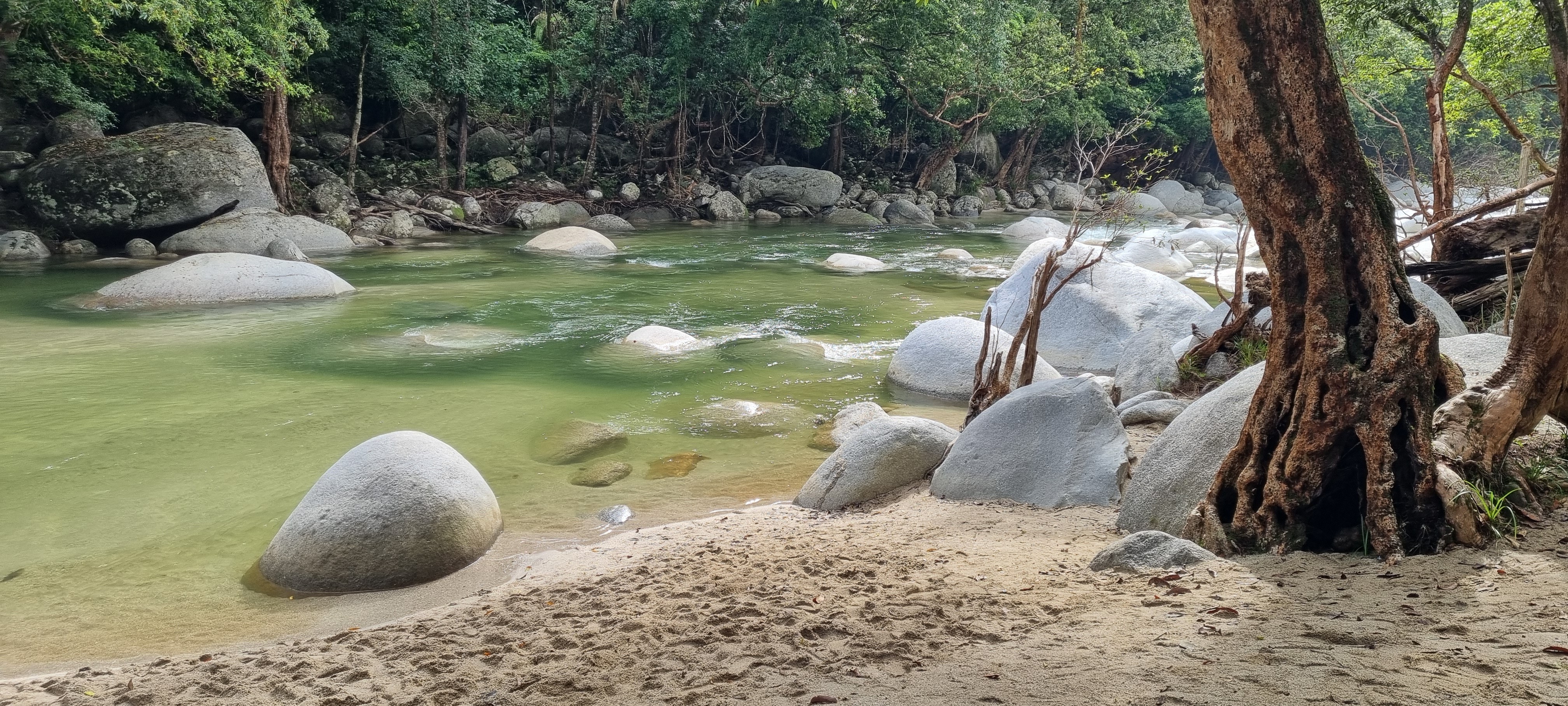
You don’t have to be a dedicated ‘twitcher’ (someone who travels a long distance to see a rare bird) but you could easily become one after spying some of the 350 or more beautiful species of birds in habitats including the Daintree Rainforest, the wetlands of the Atherton Tablelands and the Eubenagee Swamp National Park. There are 13 species endemic to the wet tropics alone and all are found in this area, including the Golden Bowerbird and Victoria’s Riflebird.
The distinctive markings of Double-Eyed Fig Parrots, Wompoo Fruit Doves and Yellow-Bellied Sunbirds will capture your hearts for sure and the gorgeous Blue-Faced Parrot Finch is easy to spot in pairs or flocks in the mangroves, rainforest and clearings with its grass-green colouring, cobalt blue face (males) and red tail.
Kingfishers love the tropics so look for the Little, Azure, Forest, Sacred, Collared, Red-backed and, perhaps the most handsome of all, the large Buff-Breasted Paradise Kingfisher who visits to breed from October to April. The male has an orange bill and is blue and black above with a chestnut/yellow breast and two showy long white tail plumes.
While the iconic Laughing Kookaburra, also a member of the kingfisher family, is found in many regions of Australia, the Blue-Winged Kookaburra inhabits the northern half of the country and is noted for its calls which are referred to by experts as a ‘cacophony of awful squawks’, so you will know them when you hear them! You’ll also know when to look out for the strutting Southern Cassowary as you’ll see the road-sign warnings in the areas it inhabits. These majestic birds are flightless and a stunning sight with their helmet-like heads, blue throats and long red ‘wattles’.
For an expert view, a bird-watching tour is highly recommended – early morning on the Mossman or Daintree Rivers to look for herons, kingfishers and sea eagles, for example. On the Atherton Tablelands bird-watching is a serious affair with wetland, forest, eucalypt and other habitats within an easy drive with guided walks and tours available.
The highlight for most birdwatchers is to see the Southern Cassowary (Casuarius casuarius) in its natural environment. These shy birds can often be seen from the boardwalks in the Daintree National Park, just north of the Daintree River.
The Southern Cassowary exclusively lives in the rainforest and usually close to water, often feeding at the edge of clearings. This bird will travel large distances each day feeding on fallen rainforest fruits, fungi & small dead animals. The Southern Cassorwary is the only disperser of some of the larger rainforest seeds.
Threatened by loss of habitat, vehicles, attack by dogs and feral animals, The Southern Cassowary is endangered. For most of the year The Southern Cassowary is a solitary bird, and only pair for mating. Generally shy by natures, this bird can be aggressive and dangerous, particularly when raising chicks.
Size: Adult stands 1.5-2.0metres high. Weight 38-47kg. This large, flightless bird belongs to the ratite group of birds, along with the Emu, the Rhea of South America and the Ostrich of Africa. It is the only species of cassowary in Australia.
Adults: Body glossy and black with course plumage. A tall helmet or ‘casque’ on the head, made from keratinous material, and which grows with maturity. Skin on the face and neck is blue (red at rear of neck), and large, brilliant blue and red wattles hang from the front of the neck. Wattles may change colour according to the mood. Three forward pointing toes, of which the inner toe has a prolonged toenail, which can be used as a weapon. The female is larger, brighter and has a taller casque..
Chicks: Yellow-cinnamon and black stripes to 3 months, then as a juvenile is brown bodied, has small wattles and no casque. The casque develops and body darkens with increasing age. Adult plumage in 2-3 years. May mate while still in sub-adult plumage.
Call: a variety of rumbles, roars, booms and hisses, particularly if disturbed.
Breeds: June-October. Nest deep in the forest, on the ground, lined with leaves and ferns.
Eggs: The male Cassowary will incubate the eggs and raise the chicks until approximately 12 months age. There are up to four, lustrous green eggs laid. The incubation period – approx 50 days. Male incubates eggs and raises chicks to 9-12 months of age.
The Azure Kingfisher (Acedo azurea) is commonly seen in the Daintree region year round.
The Azure Kingfisher is a small aquatic bird with a short tail and long heavy bill. Dark, glossy blue above, with whitish rear eye-spot, and chestnut below, with red-orange feet and legs. Bill black with whitish tip.
The Azure Kingfisher is mostly sedentary in a habitat of creeks, rivers, lakes and estuaries, preferring shade and overhanging trees where it can fish from favoured perches. Feeds on fish, small crustaceans and tadpoles.
Size – 17-19cm. With the Little Kingfisher, the only Australian members of the Alcedo Kingfishers which are specialists at exclusively deep diving into water for their prey. They have three toes, two of which point forwards.
Call is a high, thin whistle in flight and often when perched. Frequent sharp squeaking when breeding.
Breeds: October to March, nesting in a tunnel 45-70cm long in a vertical bank, usually high over water but sometimes in dry gullies to avoid flooding of nests. Both birds dig the tunnel. Incubation 3 weeks and young fledge at 28-31 days. Both parents incubate eggs. Eggs round, white and 4-7 are laid.





Enter your details below to receive updates about our recent articles, and special offers.